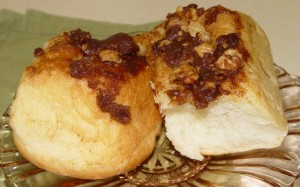Cinnamon. It should be on tables in restaurants along with salt and pepper. Anytime someone says, “Ooh, this is so good – what’s in this?” the answer invariably comes back, “cinnamon.” Cinnamon. Again and again.
– Jerry Seinfeld
Contents
Cinnamon:
In a previous post, I mentioned that cumin might be the most popular spice after black pepper. Well, if that’s true, cinnamon must a close third. How can anybody think about baking, especially now at Christmas, and not consider at least one recipe without it.
But it is more than just cinnamon buns, toast, mulled apple cider or those little red Valentine’s Day candies. It can be used to flavour all kinds of food. In fact, just recently, I sampled some chili that had a strong cinnamon flavour.

Description:
True cinnamon is very rare, and it is likely that you have probably never tasted it. It is the inner bark of a type of laurel tree grown mostly in Sri- Lanka. What we in North America know as cinnamon comes from a similar tree, grown in Vietnam, China, and Indonesia, called cassia.
We often see cinnamon as tubes of dried bark call quills. In this form, true cinnamon and cassia are easy to tell apart. Cinnamon has a tan colour and is thin and brittle. The quills are composed of several thin layers of bark. Cassia has a much darker red-brown colour. It is very hard and much thicker than cinnamon and so the tubes are hollow. Probably the easiest way to tell cinnamon and cassia apart is price. True cinnamon is more expensive 😉
Taste:
It has a sweet, slightly spicy taste, but the real essence comes from its smell. Cinnamon has a sweet woody fragrance with citrus and clove components. Cassia has a stronger and harsher aroma.
You may find something called Vietnamese (or Saigon) cinnamon. This is a type of cassia that has double the volatile oils as Indonesia cassia, and therefore has a much more intense flavour and aroma.
Uses:
Cinnamon is very versatile. It is used in baking and cooking. It is used to flavour candies, gums, and even toothpaste. The cola taste found in popular soft drinks comes mainly from vanilla and cinnamon.
In Asia where it is native, it is rarely used in deserts. It is however an essential ingredient in curries and other spice mixture (such as Chinese five spice).
In the middle east, it is also popular in savory dishes, particularly chicken or lamb dishes.
Mexico is the world’s biggest importer of Sri-Lankan cinnamon. It is used in chocolate making, and is also a key ingredient in mole sauces.
I mostly use cinnamon in desserts, snacks, and other treats. I really enjoy apple and pumpkin pies, spice cakes and cinnamon buns. I have used it to flavour apple sauce and whipped cream. I have also made cinnamon tortilla chips to go with a strawberry salsa.

I have to admit, I’ve never really tried using it in a savory recipe. But, after researching this post, I think I will definitely give it a try. If I have any success, I’ll post an update.
How do you like to use cinnamon? Please leave a comment and let me know.
Storage:
Like a lot of spices, it should be stored in a tightly sealed container, and kept in a cool dark and dry cupboard or in the fridge. Sticks can last for about a year without losing too much flavour. Ground cinnamon will last for about six months.
Health Risks / Benefits:
Cinnamon has been called a super food, and it has been associated with numerous medicinal powers. It has been found to act as an anti-inflammatory and an anti-clotting agent. The essential oils found are also “anti-microbial”, preventing bacteria and fungi growth. There have been studies that suggest cinnamon can control or even lower blood sugar levels.
Cinnamon and cassia contain chemicals called coumarins. Coumarins occur naturally in plants and are strong anticoagulants. Too much coumarin may pose a serious health threat in that our blood may not clot in times of injury. True cinnamon contains very small amounts of coumarin, but the levels found in cassia are higher.
Nutrition Facts:
Serving Size (7 g)
| Calories | 19 (1 from fat) | |
| Total carbohydrates | 6 g | 2% DV |
| Dietary fiber | 4 g | 16% DV |
| Calcium | 8% DV | |
| Iron | 4% DV |
DV based on 2000 calorie /day diet.

Leave a Reply